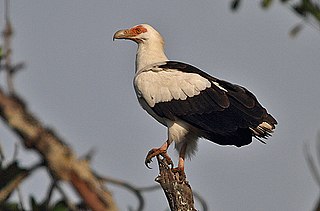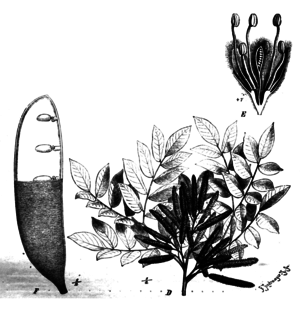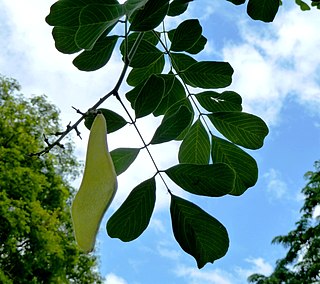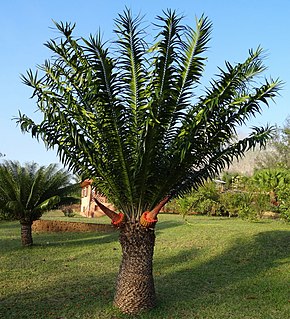
The palm-nut vulture or vulturine fish eagle, is a large bird of prey in the family Accipitridae. It is the only member of the genus Gypohierax.
The lesser seedcracker or Nyasa seedcracker is a fairly common species of estrildid finch found in eastern Africa. It has an estimated global extent of occurrence of 925,000 km2 (357,000 sq mi) and is found in Malawi, Mozambique, Tanzania and Zimbabwe. The International Union for Conservation of Nature has classified the species as being of least concern.
Guibourtia ehie is an evergreen tree of the genus Guibourtia in the family Fabaceae, also known by the common names amazique, amazoué, hyedua, black hyedua, mozambique, ovangkol and shedua.

Millettia is a genus of legume in the family Fabaceae. It consists of about 150 species, which are distributed in the tropical and subtropical regions of the world. The genus was formerly known by the name Pongamia, but that name was rejected in favor of the name Millettia, and many species have been reclassified. Due to recent interest in biofuels, Pongamia is often the generic name used when referring to Millettia pinnata, a tree being explored for producing biodiesel.
Millettia bussei is a species of plant in the family Fabaceae. It is found in Mozambique and Tanzania.
Newtonia paucijuga is a species of legume in the family Fabaceae. It is found in Kenya and Tanzania.
Hexalobus mossambicensis is a species of plant in the Annonaceae family. It is endemic to Mozambique.
Thespesia mossambicensis is a species of flowering plant in the mallow family, Malvaceae, that is endemic to Mozambique.

The Maputaland-Pondoland-Albany Hotspot (MPA) is a biodiversity hotspot, a biogeographic region with significant levels of biodiversity, in Southern Africa. It is situated near the south-eastern coast of Africa, occupying an area between the Great Escarpment and the Indian Ocean. The area is named after Maputaland, Pondoland and Albany. It stretches from the Albany Centre of Plant Endemism in the Eastern Cape Province of South Africa, through the Pondoland Centre of Plant Endemism and KwaZulu-Natal Province, the eastern side of Eswatini and into southern Mozambique and Mpumalanga. The Maputaland Centre of Plant Endemism is contained in northern KwaZulu-Natal and southern Mozambique.

Millettia grandis is a species of plant in the family Fabaceae from South Africa. It is commonly called umzimbeet which is a name derived from the isiZulu name umSimbithwa.

Xylocarpus granatum, commonly known as the cannonball mangrove, cedar mangrove, or puzzlenut tree, is a species of mangrove in the mahogany family (Meliaceae). It is found in Africa, Asia, Australasia and the Pacific Islands. It is a common species of mangrove, and the International Union for Conservation of Nature has assessed its conservation status as being of "least concern".

Erythrophleum suaveolens, also known as the ordeal tree, is a species of flowering plant that can be found across most of tropical Africa. The species are 20 metres (66 ft) in height, and have a rough and blackish bark. The plants leaves have 2–3 pairs of pinnae, which carry 7–13 leaflets. The leaflets are 5 by 2.5 centimetres, are green coloured and ovate. The flowers have fluffy spikes, and are creamy-yellow coloured. Fruits are hard, the pod of which is flat.

Millettia stuhlmannii, commonly known as panga panga, is a well-known species of timber tree that is native to the southeastern Afrotropics. The wood of the tropical species M. laurentii has similar qualities and uses, but is slightly darker, and lacks the copious yellowish white resin of the heartwood vessels. Its foliage is similar to that of Pterocarpus rotundifolius, and it may be confused with the latter when observed from a distance.

Encephalartos turneri is a species of cycad that is native to Mozambique. The Encephalartos turneri was discovered by Ian Sutherland Turner in Nampula, Mazambique.

Encephalartos gratus is a species of cycad that is native to Malawi and Mozambique.

Weinmannia pinnata, commonly known as the bastard briziletto, is a species of tree in the family Cunoniaceae. It is native to Mexico, Central America, South America and the West Indies. It typically grows in wet habitats at high altitudes, and is one of the species found in dwarf forests perpetually wreathed in clouds.
Elephantorrhiza suffruticosa, commonly known as the skew-leaved elephant-root, is a species of legume in the family Fabaceae. It is a deciduous, multi-stemmed shrub or rarely a tree of 4 to 8 meters tall, which may be found on hills as well as plains. The type material was obtained south of Humbe, Angola. E. rangei of southern Namibia is now considered a synonym.

Brunellia comocladifolia, commonly known as the West Indian sumac, is a species of tree in the family Brunelliaceae. It is native to Central America, the West Indies, and northern South America.

Gilbertiodendron dewevrei is a species of tree in the family Fabaceae, native to tropical rain forests in Central Africa. It is often the dominant tree species of the Guineo-Congolian rainforest. The timber is traded as limbali, and is used for construction, flooring and railway sleepers. It is also used for making boats, furniture, tool handles and joinery and for making charcoal.
Parkia bicolor, the African locust-bean, is a species of flowering plant, a tree in the pea family, Fabaceae. It is native to tropical West and Central Africa. Its natural habitats are tropical moist lowland forests, swampland, woodland and savannah.













